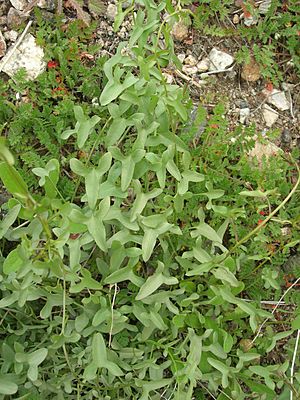Peirson's false bindweed facts for kids
Quick facts for kids Peirson's false bindweed |
|
|---|---|
 |
|
| Scientific classification | |
| Genus: |
Calystegia
|
| Species: |
peirsonii
|
Calystegia peirsonii, also known as Peirson's false bindweed, is a special type of morning glory plant. It is found only in a small area of Los Angeles County, California. This plant grows where the San Gabriel Mountains meet the Mojave Desert, near the Antelope Valley. This means it is endemic to that specific place, which is like saying it's a local celebrity plant!
Contents
What Does Peirson's False Bindweed Look Like?
This plant is a perennial herb, which means it lives for more than two years and has soft stems, not woody ones like a tree. It grows from underground stems called rhizomes. These rhizomes help the plant spread and grow new shoots.
Stems and Leaves
Peirson's false bindweed has stems that can lie low on the ground or climb up to 40 centimeters (about 16 inches) long. These stems feel smooth and a bit waxy. Its leaves are small, usually no more than 2 centimeters (less than an inch) long. They are often shaped like a triangle and have small rounded sections, called lobes.
Flowers
The plant produces beautiful flowers that look like funnels, just like other morning glories. These white flowers can open up to 4 centimeters (about 1.5 inches) wide. They grow on short stalks called peduncles. At the base of these stalks, there are small, rounded leaves called bracts. These bracts usually cover only part of the flower's base.
How Is It Different from Similar Plants?
Peirson's false bindweed looks a lot like another plant called Calystegia occidentalis. Sometimes, both plants can even grow in the same area! However, there are a few ways to tell them apart:
- The bracts on C. occidentalis are longer and have sharper points. They also grow a bit lower down on the stem.
- The leaves of C. occidentalis are usually more triangular and have less clear lobed sections.

